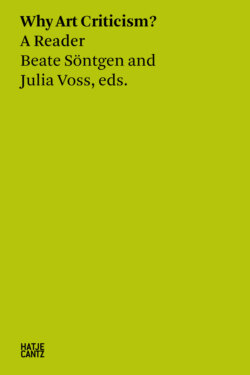Читать книгу Why Art Criticism? A Reader - Группа авторов - Страница 18
На сайте Литреса книга снята с продажи.
ОглавлениеCrafts and the Spiritual:
Ananda K. Coomaraswamy
Monica Juneja
The book The Indian Craftsman by Ananda K. Coomaraswamy, from which the following extract has been chosen, addresses a seminal question about processes of artistic creativity. In doing so, the author chooses not to privilege European humanist concepts and the values they transport—canons that have long enjoyed the claim to universal validity within art history. Coomaraswamy’s approach is rather anti-modernist and anti-industrialist. Like all his writings, it makes a strong case for grasping the dynamics of Indian art not through the lens of form alone, but rather based on prior knowledge of iconography, philology, theology, and metaphysics. The Indian Craftsman is framed along a binary axis that posits materialism against spiritualism, while the text’s critique of industrial modernity valorizes collective labor and social cohesion as vital aspects underpinning art production. At the same time, the work relies on an ethnographic method of direct observation that contrasts to the philological approach and philosophical abstraction that mark the author’s later work. Although the anti-colonial framing of Coomaraswamy’s writings has meant that they are frequently couched in a language of a nativist nationalism, the possibilities inherent in an approach that conceives of art as a holistic, ethical praxis, which lives from a connection between the hand and mind, merit investigation.
The choice of this text stems from an interest in making its content productive for an art history informed by a notion of critical globality—in other words, a perspective that aspires to make insights from regions beyond the Western European–North Atlantic axis globally intelligible and capable of being critically worked back into the mainstream discipline. Can an approach that counters the idea of art as representation and urges us instead to look at art as making, as contingent on skilled ways of knowing that conjoin materiality with knowledge and experimentation, help in rethinking art history in a global context? Coomaraswamy’s critique of modernity shows the way to questioning existing distinctions, such as art versus artifact, that downgrade or exclude many historically and aesthetically significant kinds of objects and practices from consideration. Further, making materiality central to the experience of art, to its production and reception, helps pluralize our understanding of concepts such as vision, by making art history more capacious for notions of sight that go beyond the purely ocular and prevail in different world cultures. Drawing our attention to skills of art making is an important reminder that processes of knowledge production are as much material as they are textual. In the context of South Asia—though probably applicable to other traditions in the world—it is important not to fall into the trap of considering canonical texts, for example in Sanskrit, as manuals for artists. These instead were composed as a set of abstract norms, were often transmitted orally, and most importantly, learned as skills translated into practice.
Coomaraswamy’s insights serve as a basis to argue that a society’s conceptual knowledge about art was not produced exclusively within lexical repositories; it was equally reconfigured through practice and experiment, and percolated through and within workshops. The art-critical potential of Coomaraswamy’s text that views the significance of a work of art beyond the intentionality of its maker lies in a kind of artisanal epistemology. It describes art making as an ensemble of manual skills, technical procedures, material practices—often indirectly transmitted—together with other sources. Artisanal epistemology sensitizes us to look for a distributed agency that takes us beyond the individual artist, whom art history, conditioned during its formation by an evolutionist logic, tends to canonize as the pinnacle of creativity.
Pursuing these insights today could lead us towards a non-totalizing, transcultural approach to art history that must also consider migration as a logical condition of art making. For materials and technologies, and—not least—the craftsmen themselves were important links in a network of connectivities among things, peoples, and ideas from all time periods and geographical locations. Studying these beyond national units will allow us to negotiate existing gaps and discontinuities within art-historical understanding that we continue to grapple with.
